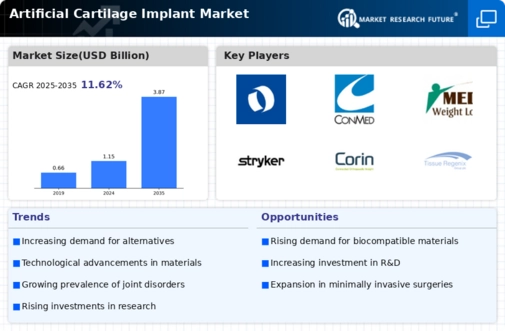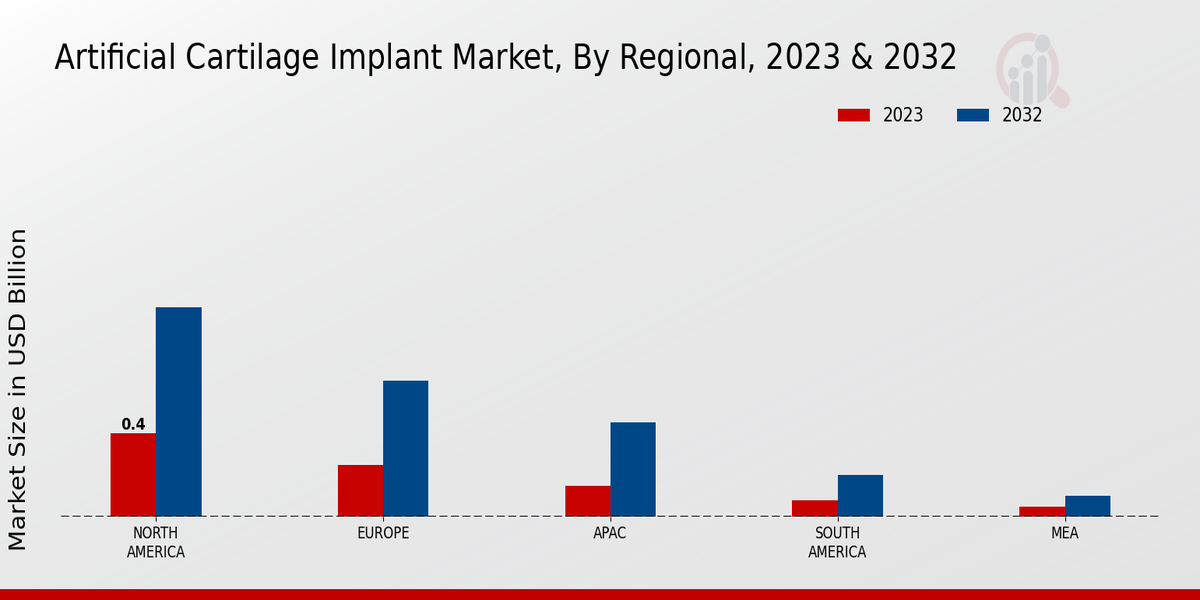Market Growth Projections
The Global Artificial Cartilage Implant Market Industry is poised for substantial growth, with projections indicating a rise from 1.15 USD Billion in 2024 to 3.87 USD Billion by 2035. This growth trajectory reflects a compound annual growth rate of 11.67% from 2025 to 2035, underscoring the increasing demand for innovative joint repair solutions. Factors contributing to this growth include advancements in technology, rising prevalence of joint disorders, and an aging population. The market's expansion presents opportunities for stakeholders to invest in research and development, ultimately leading to improved patient outcomes and enhanced healthcare solutions.
Rising Geriatric Population
The rising geriatric population is a significant driver of the Global Artificial Cartilage Implant Market Industry. As individuals age, the likelihood of developing joint-related issues increases, leading to a higher demand for effective treatment options. The demographic shift towards an older population necessitates innovative solutions to address the unique healthcare needs of seniors. With the market projected to grow from 1.15 USD Billion in 2024 to 3.87 USD Billion by 2035, the implications of this trend are profound. The increasing focus on improving the quality of life for the elderly population will likely propel the adoption of artificial cartilage implants.
Rising Prevalence of Joint Disorders
The Global Artificial Cartilage Implant Market Industry is experiencing growth due to the increasing prevalence of joint disorders, such as osteoarthritis and rheumatoid arthritis. As populations age, the incidence of these conditions rises, leading to a greater demand for effective treatment options. In 2024, the market is valued at 1.15 USD Billion, reflecting the urgent need for innovative solutions in joint repair. The growing awareness of artificial cartilage implants as a viable alternative to traditional surgical methods further drives this trend. With advancements in materials and technology, these implants offer improved outcomes, potentially enhancing the quality of life for millions globally.
Technological Advancements in Implant Design
Technological advancements in implant design are significantly influencing the Global Artificial Cartilage Implant Market Industry. Innovations in biomaterials and 3D printing techniques are enabling the development of more effective and durable implants. These advancements not only improve the performance of artificial cartilage but also reduce the risk of complications associated with traditional implants. As a result, healthcare providers are increasingly adopting these new technologies, contributing to the market's projected growth. The anticipated compound annual growth rate of 11.67% from 2025 to 2035 indicates a robust future for this sector, driven by continuous improvements in design and functionality.
Increasing Investment in Healthcare Infrastructure
The Global Artificial Cartilage Implant Market Industry is benefiting from increasing investment in healthcare infrastructure across various regions. Governments and private entities are recognizing the importance of enhancing healthcare facilities to accommodate advanced medical technologies. This investment leads to improved access to artificial cartilage implants and related surgical procedures. As healthcare systems evolve, the demand for innovative solutions in joint repair is likely to rise. The market's growth trajectory, with a valuation of 3.87 USD Billion projected by 2035, suggests that enhanced infrastructure will play a crucial role in facilitating the adoption of artificial cartilage implants.
Growing Awareness and Acceptance of Minimally Invasive Procedures
The growing awareness and acceptance of minimally invasive procedures are reshaping the Global Artificial Cartilage Implant Market Industry. Patients increasingly prefer treatments that minimize recovery time and reduce surgical risks. Artificial cartilage implants, often associated with less invasive techniques, align with this trend, making them more appealing to both patients and healthcare providers. As educational initiatives and patient advocacy efforts continue to promote these options, the market is likely to see a surge in demand. This shift towards minimally invasive solutions is expected to contribute to the overall growth of the market in the coming years.























Leave a Comment